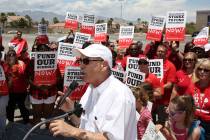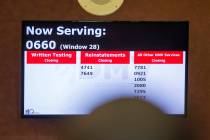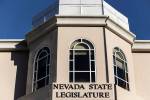Badly needed pension reforms dead – again
When Republican Gov. Brian Sandoval called for yet another study of the Nevada Public Employees’ Retirement System — one that won’t wrap up until the current legislative session is over — he signaled he had no appetite to take on the issue before his re-election campaign, if ever.
That stole whatever wind might have lingered in the sails of Assembly Bill 342, sponsored by Randy Kirner, R-Reno, a reform proposal Mr. Kirner announced Monday is not likely to get a hearing this session, at all. He might as well have set it on fire and held a nice Viking funeral.
Mr. Kirner’s bill proposed a hybrid retirement plan for all future Nevada government hires, with a 6 percent contribution from public employers to a worker’s defined-benefit pension. The other part would consist of a defined-contribution plan, with employees putting in 6 percent of their salaries and employers providing a 6 percent match. The bill also would have eliminated employees’ ability to purchase years of service, allowing them to retire and start collecting their pension early, and set the retirement age for regular public workers at the same age taxpayers are eligible for Social Security benefits.
It’s not as radical a solution as simply putting all new hires in a 401(k)-style plan, but AB 342 represented the best compromise likely to survive in a Legislature where public employee unions still wield disproportionate influence.
The state’s current pension system is a defined-benefit plan, which creates long-term financial obligations for state and local government agencies. The benefits have been promised to about 100,000 current state and local government workers and more than 40,000 retirees. The plan was 85 percent funded in 2000, but only 71 percent funded in 2012, after years of modest investment performance. The unfunded liability was $11.2 billion as of June 30, 2012, an increase of $1.2 billion over the past two years — officially.
But a study conducted for the Nevada Policy Research Institute by Andrew Biggs warns PERS is using an unrealistically high estimate of what it’s likely to earn on its portfolio of stocks and bonds. Mr. Biggs puts the unfunded liability closer to $41 billion.
“PERS’s unfunded liability is slightly larger than all spending from the state general fund between FY 1986 and FY 2010 — a period of 25 years,” writes NPRI Deputy Policy Director Geoffrey Lawrence. That’s because Nevada employees are guaranteed a certain percentage of their highest salary as a lifelong pension.
NPRI’s “Solutions 2013: A Sourcebook for Nevada Policymakers” also recommends repeal or serious reform of NRS 288, the collective bargaining statute, which has resulted in local government employees in Nevada receiving wages 31 percent higher than the national average — wages on which those aforementioned pensions are based. If those wages were reduced to the national average, taxpayers could save more than $1 billion a year, NPRI estimates.
Yet lawmakers who refused to let those proposals see the light of a committee hearing now will spend their final month in Carson City digging under the seat cushions for extra spending money, then see if they can cobble together support for a few hundred million dollars in new and higher taxes?
Is that a really big can they’re kicking down the road, or a live mortar shell?























